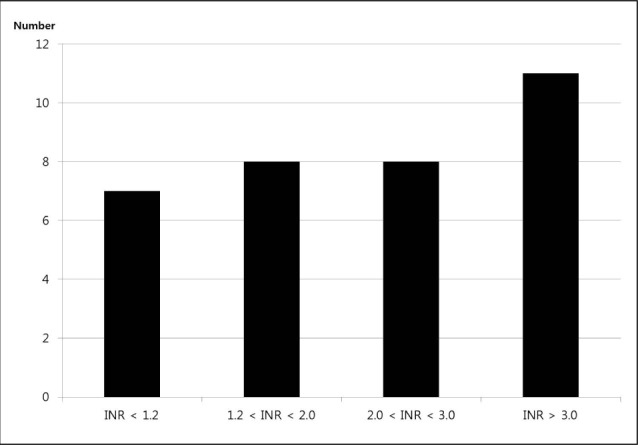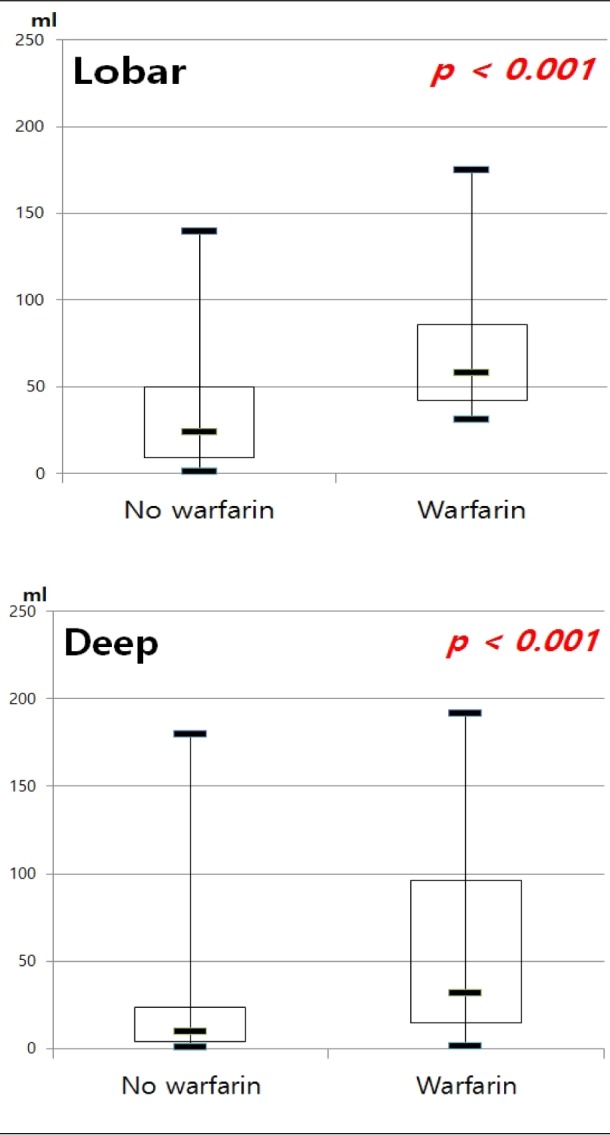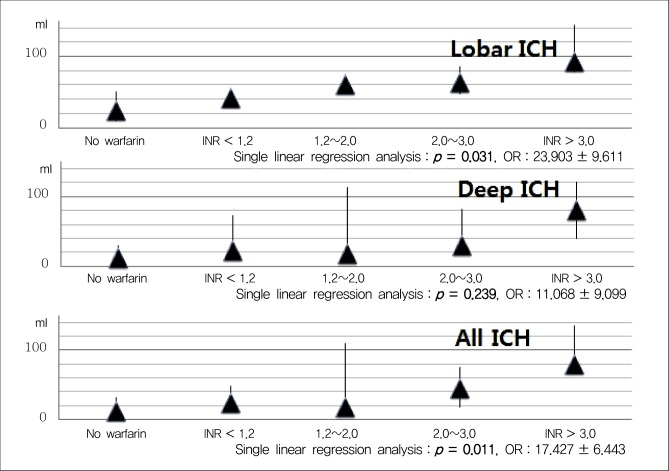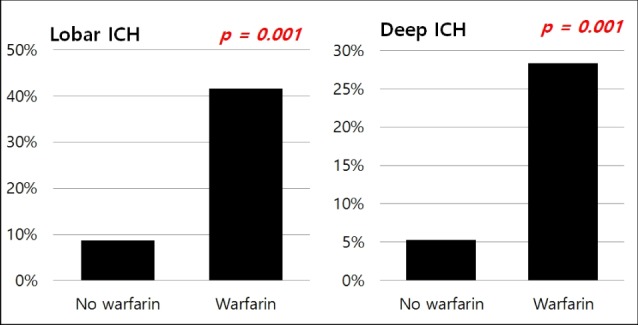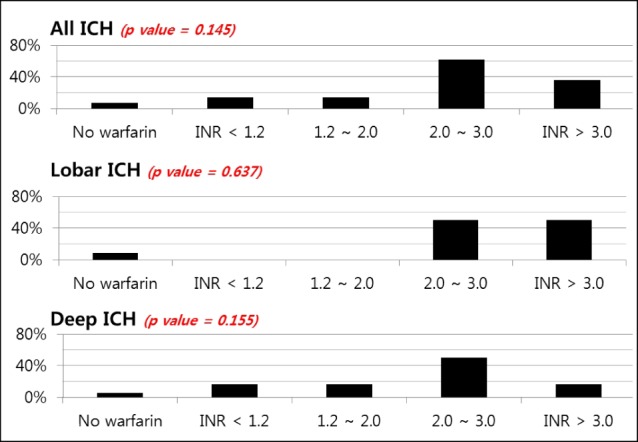J Cerebrovasc Endovasc Neurosurg.
2014 Sep;16(3):184-192. 10.7461/jcen.2014.16.3.184.
Location and Characteristics of Warfarin Associated Intracranial Hemorrhage
- Affiliations
-
- 1Department of Neurosurgery, Busan-Ulsan Regional Cardiocerebrovascular Center, Medical Science Research Center, College of Medicine, Dong-A University, Busan, Korea. jthuh@dau.ac.kr
- KMID: 1963155
- DOI: http://doi.org/10.7461/jcen.2014.16.3.184
Abstract
OBJECTIVE
In the so-called primary intracerebral hemorrhage (ICH), lobar and deep ICH were mainly due to cerebral amyloid angiopathy and deep perforating arterial disease. Our aim was to identify specifics of warfarin associated ICH (WAICH) and to focus on differences in susceptibility to warfarin according to the underlying vasculopathies, expressed by ICH location.
MATERIALS AND METHODS
We identified all subjects aged > or = 18 years who were admitted with primary ICH between January 1, 2007 and September 30, 2012. We retrospectively collected demographic characteristics, the presence of vascular risk factors and pre-ICH medication by chart reviews. We categorized ICH into four types according to location: lobar, deep, posterior fossa, and undetermined. We investigated characteristics (including hematoma volume and expansion) of ICH according to the location of ICH.
RESULTS
WAICH accounted for 35 patients (5.6%) of 622 ICH cases. In WAICH, 13 patients (37.1%) had lobar ICH and 22 patients (60.0%) had non-lobar ICH. Compared to other locations of ICH, lobar ICH showed an excess risk of WAICH (OR 2.53, 95% CI 1.03-6.21, p = 0.042). The predictors of lobar location of ICH were warfarin (OR 2.29, 95% CI 1.05-5.04, p = 0.038) and diabetes mellitus (DM) (OR 0.54, 95% CI 0.29-0.98, p = 0.044). The lobar location of ICH showed significant association with larger hematoma volume (p = 0.001) and high ratio of hematoma expansion (p = 0.037) compared with other locations of ICH.
CONCLUSION
In our study, warfarin showed significant association with lobar ICH and it caused larger hematoma volume and more expansion of hematoma in lobar ICH.
MeSH Terms
Figure
Reference
-
1. Risk factors for stroke and efficacy of antithrombotic therapy in atrial fibrillation. Analysis of pooled data from five randomized controlled trials. Arch Intern Med. 1994; 7. 154(13):1449–1457. PMID: 8018000.2. Al-Shahi Salman R, Labovitz DL, Stapf C. Spontaneous intracerebral haemorrhage. BMJ. 2009; 7. 24. 339:b2586. PMID: 19633038.
Article3. Berwaerts J, Dijkhuizen RS, Robb OJ, Webster J. Prediction of functional outcome and in-hospital mortality after admission with oral anticoagulant-related intracerebral hemorrhage. Stroke. 2000; 11. 31(11):2558–2562. PMID: 11062275.
Article4. Broderick JP, Brott TG, Duldner JE, Tomsick T, Huster G. Volume of intracerebral hemorrhage. A powerful and easy-to-use predictor of 30-day mortality. Stroke. 1993; 7. 24(7):987–993. PMID: 8322400.
Article5. Cucchiara B, Messe S, Sansing L, Kasner S, Lyden P. CHANT Investigators. Hematoma growth in oral anticoagulant related intracerebral hemorrhage. Stroke. 2008; 11. 39(11):2993–2996. PMID: 18703803.
Article6. Delcourt C, Huang Y, Arima H, Chalmers J, Davis SM, Heeley EL, et al. INTERACT1 Investigators. Hematoma growth and outcomes in intracerebral hemorrhage: the INTERACT1 study. Neurology. 2012; 7. 79(4):314–319. PMID: 22744655.
Article7. Dequatre-Ponchelle N, Hénon H, Pasquini M, Rutgers MP, Bordet R, Leys D, et al. Vitamin K antagonists-associated cerebral hemorrhages: what are their characteristics? Stroke. 2013; 2. 44(2):350–355. PMID: 23287784.8. Diringer MN, Skolnick BE, Mayer SA, Steiner T, Davis SM, Brun NC, et al. Thromboembolic events with recombinant activated factor VII in spontaneous intracerebral hemorrhage: results from the Factor Seven for Acute Hemorrhagic Stroke (FAST) trial. Stroke. 2010; 1. 41(1):48–53. PMID: 19959538.9. Fang MC, Chang Y, Hylek EM, Rosand J, Greenberg SM, Go AS, et al. Advanced age, anticoagulation intensity, and risk for intracranial hemorrhage among patients taking warfarin for atrial fibrillation. Ann Intern Med. 2004; 11. 141(10):745–752. PMID: 15545674.
Article10. Flaherty ML, Kissela B, Woo D, Kleindorfer D, Alwell K, Sekar P, et al. The increasing incidence of anticoagulant-associated intracerebral hemorrhage. Neurology. 2007; 1. 68(2):116–121. PMID: 17210891.
Article11. Flaherty ML, Tao H, Haverbusch M, Sekar P, Kleindorfer D, Kissela B, et al. Warfarin use leads to larger intracerebral hematomas. Neurology. 2008; 9. 71(14):1084–1089. PMID: 18824672.
Article12. Flibotte JJ, Hagan N, O'Donnell J, Greenberg SM, Rosand J. Warfarin, hematoma expansion, and outcome of intracerebral hemorrhage. Neurology. 2004; 9. 63(6):1059–1064. PMID: 15452298.
Article13. Gage BF, Waterman AD, Shannon W, Boechler M, Rich MW, Radford MJ. Validation of clinical classification schemes for predicting stroke : results from the National registry of atrial fibrillation. JAMA. 2001; 6. 285(22):2864–2870. PMID: 11401607.14. Hart RG, Pearce LA, Aguilar MI. Meta-analysis: antithrombotic therapy to prevent stroke in patients who have nonvalvular atrial fibrillation. Ann Intern Med. 2007; 6. 146(12):857–867. PMID: 17577005.
Article15. Huttner HB, Schellinger PD, Hartmann M, Kohrmann M, Juettler E, Wikner J, et al. Hematoma growth and outcome in treated neurocritical care patients with intracerebral hemorrhage related to oral anticoagulant therapy: comparison of acute treatment strategies using vitamin K, fresh frozen plasma, and prothrombin complex concentrates. Stroke. 2006; 6. 37(6):1465–1470. PMID: 16675739.16. Itabashi R, Yasaka M, Kuwashiro T, Nakagaki H, Miyashita F, Naritomi H, et al. Location of acute brain hemorrhage in patients undergoing antithrombotic therapy. J Neurol Sci. 2009; 5. 280(1-2):87–89. PMID: 19254798.
Article17. Jeffree RL, Gordon DH, Sivasubramaniam R, Chapman A. Warfarin related intracranial haemorrhage: a case-controlled study of anticoagulation monitoring prior to spontaneous subdural or intracerebral haemorrhage. J Clin Neurosci. 2009; 6. 16(7):882–885. PMID: 19342242.
Article18. Jorgensen HS, Nakayama H, Reith J, Raaschou HO, Olsen TS. Stroke recurrence: predictors, severity, and prognosis. The Copenhagen stroke study. Neurology. 1997; 4. 48(4):891–895. PMID: 9109873.
Article19. Kothari RU, Brott T, Broderick JP, Barsan WG, Sauerbeck LR, Zuccarello M, et al. The ABCs of measuring intracerebral hemorrhage volumes. Stroke. 1996; 8. 27(8):1304–1305. PMID: 8711791.
Article20. Labovitz DL, Boden-Albala B, Hauser WA, Sacco RL. Lacunar infarction or deep intracerebral hemorrhage: who gets which? The northern Manhattan study. Neurology. 2007; 2. 68(8):606–608. PMID: 17310033.21. Lovelock CE, Molyneux AJ, Rothwell PM. Oxford vascular study. Change in incidence and etiology of intracerebral haemorrhage in Oxfordshire, UK, between 1981 and 2006: a population-based study. Lancet Neurol. 2007; 6. 6(6):487–493. PMID: 17509483.22. Mittal MK, Rabinstein AA. Anticoagulation-related intracranial hemorrhages. Curr Atheroscler Rep. 2012; 8. 14(4):351–359. PMID: 22638877.
Article23. Nilsson OG, Lindgren A, Brandt L, Saveland H. Prediction of death in patients with primary intracerebral hemorrhage: a prospective study of a defined population. J Neurosurg. 2002; 9. 97(3):531–536. PMID: 12296635.
Article24. Radberg JA, Olsson JE, Radberg CT. Prognostic parameters in spontaneous intracerebral hematomas with special reference to anticoagulant treatment. Stroke. 1991; 5. 22(5):571–576. PMID: 2028484.
Article25. Rosand J, Eckman MH, Knudsen KA, Singer DE, Greenberg SM. The effect of warfarin and intensity of anticoagulation on outcome of intracerebral hemorrhage. Arch Intern Med. 2004; 4. 164(8):880–884. PMID: 15111374.
Article
- Full Text Links
- Actions
-
Cited
- CITED
-
- Close
- Share
- Similar articles
-
- Sonographic Diagnosis of Fetal Intracranial Hemorrhage in a Gravida on Warfarin Therapy
- Delayed Multiple Intracerebral Hemorrhage After Burr Hole Drainage of Chronic Subdural Hematoma During Failure of Warfarin Resumption in Atrial Fibrillation
- Spontaneous Spinal Subdural Hematoma with Simultaneous Cranial Subarachnoid Hemorrhage
- Warfarin-Induced Intracerebral Hemorrhage Associated with Microbleeds
- Interaction of Rifampin and Warfarin

